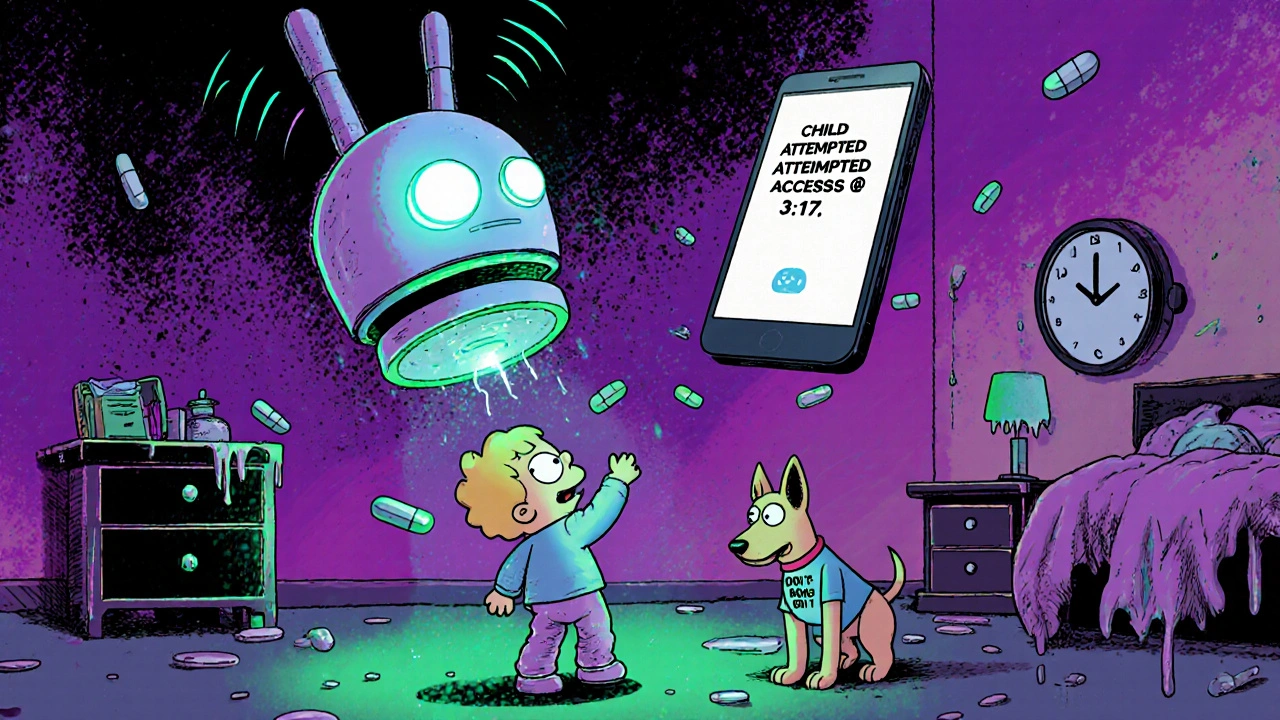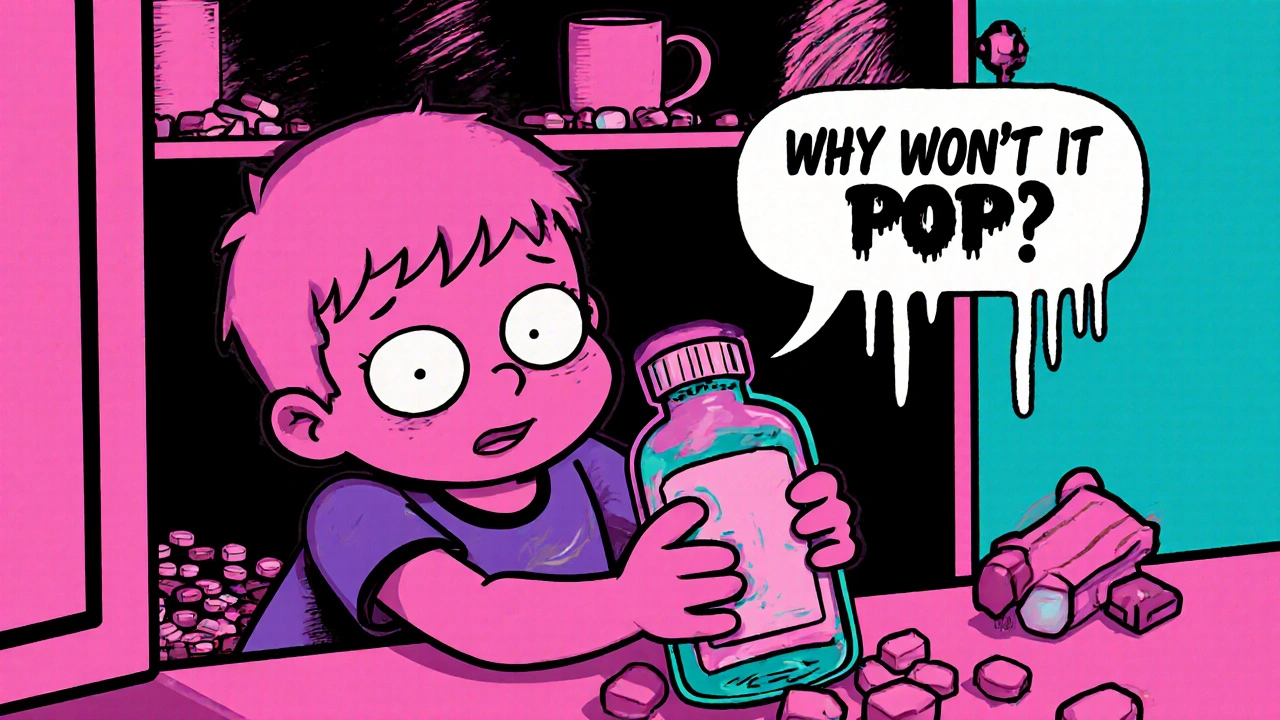Every year, thousands of young children accidentally get into medicines they shouldn’t. It’s not because they’re curious little explorers-it’s often because the bottle wasn’t properly closed, or the cap was too easy to twist off. That’s where child-resistant containers come in. They’re not magic. They don’t make medicine safe by themselves. But when used right, they can be the difference between a close call and a trip to the ER.
What Exactly Is Child-Resistant Packaging?
Child-resistant packaging, or CR packaging, is designed to slow down or block kids under five from opening a container and getting to the medicine inside. It’s not child-proof. That’s a common mistake. No cap is 100% foolproof. A determined 5-year-old with time and a rock might still get in. But CR packaging is built to make it hard enough that most kids won’t succeed within 10 minutes-especially if they’ve never seen an adult open it. The U.S. set the standard back in 1970 with the Poison Prevention Packaging Act (PPPA). Before that, accidental poisonings from medicines were climbing fast. Between 1961 and 1966, over 5,000 children died from ingesting household chemicals and drugs. Today, thanks to CR packaging and better education, that number has dropped by 45%. That’s about 900,000 poisonings prevented every year.How Do These Caps Actually Work?
Most CR caps use a trick: they need two different motions at the same time. The classic example? Push down and turn. You can’t just twist it off like a regular bottle. You have to press the cap firmly while turning it left. If you don’t press, it won’t budge. That’s too hard for small hands to coordinate. Other designs include squeeze-and-turn caps, where you have to compress the sides while twisting. Some use interlocking pieces that only align when you push, twist, and pull in sequence. These aren’t random designs-they’re tested on real kids and real seniors. Here’s how testing works: 50 children between 42 and 51 months old are given a sealed container. They have 10 minutes to open it. At least 85% must fail. Then, the ones who failed get a 5-minute demo from an adult. After that, they try again. If more than 20% still open it, the design fails. At the same time, 100 adults over 50 must open and reseal the container in under 5 minutes. At least 90% must succeed. If seniors can’t open it, the cap gets rejected-even if it stops kids perfectly.Not All Medicines Have the Same Caps
You might notice that some pills come in a hard plastic vial with a twist cap, while liquid medicine comes in a bottle with a squeeze-and-turn top. That’s because different forms need different solutions. Tablets and capsules? Easy. Most use standard screw-top vials that meet CR standards 97% of the time. Liquid medicines? Tricky. They’re more likely to be in non-compliant packaging-38.7% of reported incidents involve liquids. Why? Because leak-proof, child-resistant, and easy-to-pour designs don’t always go together. Nasal sprays are the worst offenders. The CPSC says spray pumps alone aren’t child-resistant. You need a cap over the top, or a special pump that requires two actions to activate. Only about 22% of nasal sprays on the market meet the standard without modifications. Blister packs are another option. But not every blister pack is CR. Regular ones? Kids can peel the foil right off. CR blister packs need thicker foil that takes at least 15 pounds of force to break through. That’s like pressing down with your whole palm, not just a fingertip.
Who Struggles With These Caps?
CR packaging helps kids-but it can hurt older adults. Arthritis, shaky hands, or reduced grip strength make these caps a nightmare. A 2022 survey found 68% of people with hand problems had trouble opening medication containers. Some caps require over 5 pounds of force. The recommended limit for seniors is 5 pounds. Many caps exceed that. Pharmacists hear it all the time: “I can’t open this.” Some patients give up and leave the cap off. Others cut the top off with scissors. That defeats the whole purpose. Newer designs are getting better. Companies like Aptar Pharma and Blisterpak now make “senior-friendly” CR caps that still block kids but are easier for adults. One Amazon product with this design has 4.2 out of 5 stars from over 1,200 reviews. One user wrote: “Finally, a child-safe cap my 70-year-old mother can open without help.”What Happens When Caps Fail?
Even with CR packaging, kids still get into medicine. In 2022, over 12,800 incidents were reported to poison control centers. The biggest reason? Improper reclosing. Over 73% of cases happened because an adult opened the bottle, didn’t secure it properly, and walked away. The second biggest? Damaged caps-cracked threads, broken locks, or caps that were pried off and reattached poorly. Testing by Consumer Reports found that some pharmacy-brand caps failed child resistance tests 22% of the time. Manufacturer-specific caps? Only 8% failed. That’s a big gap. Not all CR packaging is created equal.How Are These Caps Made and Approved?
Pharmaceutical companies don’t just pick a cap and start filling bottles. Every container closure system must be certified by a CPSC-accredited lab. Testing costs between $8,500 and $15,000 per design. That’s not cheap. They have to submit proof to the FDA in their drug application, specifically in a section called Module 3.2.P.7. The language has to be exact: “We verify in this submission that the following package meets CPSC’s standards under 16 CFR 1700.” No room for guesswork. If a company sells a product without proper CR packaging, they can face fines up to $100,000 per violation. The FDA doesn’t mess around. Even vet clinics get inspected. One survey found nearly half of veterinary practices were giving out meds in non-CR bags or envelopes-illegal under the PPPA.
What’s New in 2025?
The rules are still changing. In early 2023, the FDA cleared the first smart CR cap: Aptar’s SmartDose. It looks like a normal cap, but inside it has Bluetooth sensors that record when it’s opened. If your child gets into the medicine, your phone gets a notification. It also helps seniors remember if they took their pill. The CPSC is also looking at new threats. In 2023, they proposed rules requiring CR packaging for all edible cannabis products with more than 2mg of THC per serving. That’s because kids are eating gummies that look like candy-and they’re getting sick. Laundry pods are another focus. Right now, they’re only covered by voluntary standards. But after hundreds of poisonings, regulators are pushing to make CR packaging mandatory.What Can You Do to Stay Safe?
CR packaging is a tool-not a solution. Here’s what actually works:- Always reseal the cap after use. Don’t just twist it loosely. Push and turn until you hear or feel it lock.
- Store meds up high, out of sight. Even a locked cabinet isn’t enough if it’s at child’s eye level.
- Don’t leave pills on counters, nightstands, or purses. Kids are fast.
- If an older person in your home struggles with the cap, ask your pharmacist for a non-CR container. They can provide one if you sign a risk acknowledgment form.
- Check expiration dates. Old caps can crack or lose their grip.
- Never transfer medicine to unmarked containers. A candy jar might look harmless-but it’s not child-resistant.
Global Standards and the Future
The U.S. isn’t alone. The EU, Brazil, and India now require CR packaging for most medications. The ISO 8317 standard is helping align rules across countries. But differences still exist. For example, some countries don’t require senior-friendly testing. The market is growing fast. Experts predict it will hit $4.87 billion by 2028. Why? Aging populations need safer, easier-to-open designs. And more countries are realizing that child poisonings aren’t just tragedies-they’re preventable. The future? Packaging that does more than just block kids. It will remind adults to take their meds, track usage, and alert caregivers if something’s wrong. But the core goal stays the same: keep medicine away from children-without making it impossible for the people who need it to use.Are child-resistant caps really effective?
Yes, when used correctly. Since the 1970s, CR packaging has reduced pediatric poisoning deaths by 45%. Studies show that properly closed CR containers block over 85% of children under five from opening them within 10 minutes. But effectiveness drops if the cap isn’t resealed after use-about 73% of incidents happen because the cap was left loose or open.
Can seniors open child-resistant caps?
Many struggle. About 68% of adults with arthritis or hand weakness have difficulty opening standard CR caps. That’s why newer designs include senior-friendly features-like reduced torque, larger grips, or push-and-slide mechanisms. If you or a loved one can’t open a cap, ask your pharmacist for an alternative. They can provide non-CR packaging if you sign a form acknowledging the risk.
Why do some medicine bottles have caps that are easier to open?
Some medications-like those for seniors or people with disabilities-can be dispensed in non-child-resistant containers if the patient or caregiver signs a waiver. This is legal under 16 CFR 1700.15(b). It’s not a mistake; it’s a safety accommodation. But the container must be labeled to warn that it’s not child-resistant and should only be used where children aren’t present.
Do all over-the-counter medicines need child-resistant packaging?
No. Only OTC drugs with specific active ingredients in certain amounts require CR packaging. For example, aspirin, acetaminophen, ibuprofen, and iron supplements above certain doses must be in CR containers. But small doses or products like topical creams usually don’t require it. Always check the label-if it says “child-resistant packaging,” it’s required by law.
Can I reuse a child-resistant cap on a different bottle?
Never. CR caps are designed to fit one specific container. Reusing them on another bottle-even the same type of medicine-can break the locking mechanism or misalign the threads. This makes the cap ineffective. Always keep the original cap on the original bottle. If the cap is damaged, ask your pharmacy for a replacement.
